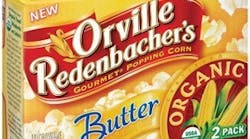Summertime means movies - action-packed thrillers, romantic comedies and thought-provoking dramas. And if you are at home curled up on the couch watching the latest DVD, you'll surely want to munch on microwave popcorn - with its fluffy kernels and tantalizing aroma.
In fact, Americans consume 17 billion quarts of popped popcorn annually or 54 quarts per man, woman and child, according to the Chicago-based Popcorn Board. Some 30 percent of popcorn is eaten outside the home, including the favorite outside venue, movie theatres - but that still leaves a significant 70 percent eaten in the home.
That's not surprising since more than 80 percent of U.S. consumers (73 million people) have a microwave at home. Popcorn also substitutes as a meal for many consumers in a pinch, and some munch on it when they are in diet mode - it's low in both calories and fat. In fact, one gallon of unbuttered popcorn has a mere 390 calories. A whole-grain food that is high in fiber, protein and other nutrients, popcorn is one of the healthiest snacks around.
Omaha-based ConAgra's Orville Redenbacher brand (then owned by Hunt-Wesson) was the first to introduce microwave popcorn in 1983, followed in 1994 by Sioux City, Iowa-based American Popcorn's Jolly Time. Other top brands include General Mills' Pop Secret, Act II (ConAgra), Smart Balance (GFA Brands Inc.) and Newman's Own, Westport, Conn.
Americans eat more popcorn than citizens of any other country, and most of the popcorn consumed throughout the world is grown in the U.S. corn belt of Iowa, Illinois, Indiana, Kansas, Kentucky, Michigan, Missouri, Nebraska and Ohio. There are more than 80 hybrids of popcorn, and they have two basic shapes when popped - snowflake (somewhat crumbly, and used most often for microwave popcorn) or butterfly. Kernels vary in color, including off-white, yellow, red, black and gold.
In the U.S. and Europe, popcorn is identified with movies and served with butter and salt, or in some regions with sugar and vinegar. Kettle corn, once served only at county fairs, is cooked with white sugar in a large copper kettle, and the sweet version has caught on over the past two years in the microwave popcorn market. In Asia and Germany, popcorn is sometimes flavored with sugar, nutritional yeast or spices. Fortunately for U.S. growers, who supply the overwhelming majority of the world's popcorn, worldwide sales are increasing steadily.
According to a Popcorn Pulse survey by Jolly Time, nine of 10 respondents watch TV or movies while munching, and 24 percent crunch while on the computer. Some 86 percent consider popcorn a healthy snack, 27 percent look for healthiest/low fat popcorn attributes, yet 84 percent concede that taste is more important than health benefits. More than half the respondents (58 percent) seek intense butter flavor.
Other available flavors include: cinnamon, chocolate, toffee, chili, blueberry, strawberry, cheese, caramel apple, and marshmallow - the list is endless. Flavors du jour include green apple, watermelon, pina colada, macaroon, pizza, peanut butter and jelly, reports the Chicago Tribune.
Popping through the ages
One of the oldest American foods, popcorn's roots trace back thousands of years. Some of the oldest ears of corn, about 4,000 years old, range from smaller than a penny to about 2 inches. They were found in 1948 by archaeologists exploring the Bat Cave in west central New Mexico.
In South America, kernels of popcorn found in burial grounds in the coastal deserts of north Chile were so well preserved they still popped even though they were 1,000 years old. Aztec Indians used popcorn in their ceremonies; young women danced a "popcorn dance" and wore garlands of popcorn in their hair during the 16th century. Today it is still a decoration for those who follow the popular tradition to string it and hang it on their Christmas tree.
Native Americans used popcorn, flavored with dried herbs and spices, as a staple in their diet. Explorer Christopher Columbus noted Native Americans used popcorn to make headdresses and corsages, which they sold to his sailors.
French explorers in the early 1600s documented the use of popcorn by the Iroquois, who popped corn in pottery using hot sand. They also consumed popcorn soup and popcorn beer, according to Wikipedia. Corn was sifted and pounded into a fine, powdery meal and later mixed with water for travelers, making it one of the first true American to-go meals.
Tribes told of spirits who lived inside each kernel of popcorn. The spirits were quiet and content to live on their own, but grew angry if their houses were heated. The hotter their homes became, the angrier they'd get - shaking the kernels until the heat was too much. Finally they would burst out of their homes and into the air as a disgruntled puff of steam.
Legend has it that Quadequina, brother of Chief Massasoit of the Wampanoag Indians, brought bowlfuls of popcorn to the first Thanksgiving for the Pilgrims to try. The Pilgrims were so enthralled with popcorn they served it for breakfast with sugar and cream - the first puffed breakfast cereal. "Each grain bursts and throws out a white substance of twice its bigness," is the way Benjamin Franklin, who was fascinated with the way it popped, described the snack in 1795.
A magic show
Part of the grain family, popcorn contains basic components of germ, starch and hull and a tiny amount of water stored inside a circle of soft starch, surrounded by the kernel's hard outer surface. As the kernel heats up, the water begins to create pressure against the hard starch and expands, forcing the insides to turn out and explode - creating a magic show of sorts.
The organic movement even has made inroads into the single-serve microwave popcorn category.
To achieve the utmost in popability, the moisture content of popcorn should be from 13 percent to 14.5 percent, with the ideal being 13.5. Processors consider the minimum expansion ratio for good popcorn to be 35-38 to one, however, some of today's improved hybrids will expand over 40 times. The average popping temperature is 347°F, and a good package of popcorn should provide at least 98 percent popped kernels with well under two percent "spinsters" or unpopped kernels.
Popcorn continued its popularity from the 1890s until the Great Depression, as street vendors pushed steam or gas-powered poppers through fairs, parks and expositions. The popcorn business thrived during the Depression because at 5 or 10 cents a bag, it was one of the few luxuries down-and-out families could afford.
The No. 1 snack selection made by the majority of adults (76 percent) may be fruit, according to Parade magazine's 2005 "What America Eats" survey. That choice barely surpasses the popularity of popcorn (74 percent). Teens and kids prefer cookies as their No. 1 snack (76 percent), but 74 percent enjoy popcorn.
On the wellness front, Omaha-based ConAgra Foods' Orville Redenbacher's and Act II microwave brands, which feature 120 products and 30 flavor varieties, are now made with 100 percent whole grains and contain zero grams of trans fats. Orville Redenbacher also has an Organic Butter flavor.
Jolly Time Healthy Pop is 94 percent fat free. Pop Secret recently debuted 100 Calorie Pop, a size that contains only 100 calories. Newman's Own contains zero trans fats, and Smart Balance popcorn has no hydrogenated fat, no trans fat, low sodium and a patented oil blend to help improve good to bad cholesterol ratios. All microwave popcorn manufacturers are rolling out mini-bags, or individual serving sizes for calorie watchers.
Snacking is a way of life for many Americans, and by making healthful choices one can provide the body with needed nutrients and fuel. Even better, microwave popcorn feels indulgent and comforting at the same time. It's also a wonder snack for families to share and enjoy.
| Brand Name | Dollar Sales (millions) | Dollar Share |
| Orville Redenbacher | $154 | 26 |
| Pop Secret | 104 | 17 |
| Private Label | 63 | 11 |
| Act II | 62 | 10 |
| Orville Redenbacher Smart Pop | 58 | 10 |
| Pop Secret Homestyle | 29 | 5 |
| Jolly Time Healthy Pop | 17 | 3 |
| Jolly Time Blast O Butter | 14 | 2 |
| Pop Secret Jumbo Pop | 11 | 2 |
| Act II Butter Lovers | 11 | 2 |
| Smart Balance | 10 | 2 |
| Orville Redenbacher Pour Over | 9 | 1.5 |
| Newman's Own | 8 | 1.4 |
| Cousin Willie's | 7 | 1.2 |
| Orville Redenbacher Homestyle | 6 | 1.1 |
| TOTAL | $599,968,900 | |
| Source: Information Resources Inc. (U.S. supermarket sales for 52 weeks ended Feb. 19) |


